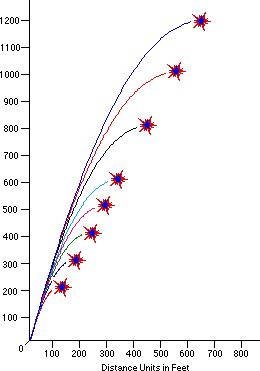![]() =
=
The physics behind every large ordinance
fireworks show is very involved and can range from vectors, velocities,
trajectories, projectiles,
and the directed force explosions from the shell. All these concepts and
relationships are explored throughout the following page. The large ordinances,
or aerial shells, are the only ones being explored in this section. The same
concepts apply to the smaller fireworks, such as bottle rockets and Blackcats©.
Aerial shells are the type of firework that is used
at most Fourth of July celebrations. These shells range from the 2” salutes to the enormous
36” shells. There are different combinations of aerial shells used
during a display, the most common are the two-break color and report shell,
the American cylinder shell, and the Oriental style shell. After the shell
has reached its designated altitude, a burst of chemicals ignite to produce
the brilliant flash of colored light. The projectile is launched from steel
or more recently PVC tubes (mortars).
.gif)
The table to the right lists all commonly
used shell sizes and their corresponding initial mortar velocities. The
initial velocity of the shell is the speed
at which the shell leaves the mortar. A typical show will use the 2" shells
as salutes before the show starts. These shells usually don’t have
any special effect except for the loud “bang” to suggest the
start of the show. The most common shells used at a small fireworks display
are below the 6" shell size. One could think of the price as being proportional
to the size of the aerial shell, of course, the more intricate design and
display from the firework itself, the more expensive. The expensive 8",
10", and 12" shell sizes are usually used at only large fireworks
shows. The 24" and 36" shell sizes are the most expensive due
to large burst patterns, materials, and production. The oversized aerial
shells
are rarely used due to the large hazards, cost, and scarcity of the shell.
The table also shows that the larger
the shell sizes, the greater the initial mortar velocities. This is an
interesting relationship, one would think that
the larger mortars would be slower out of the tube due to size and weight;
this is actually the opposite of what happens. As the shell diameter
increases, the area increases by r2 and therefore more room is allocated
for the propellant.
As larger amounts of propellant are burned, excess gas is produced and
creates the lifting force. This force is greater as the excess gas increases.
These
larger amounts of excess gases cause the shell to be pushed or propelled
out of the mortar faster, resulting in a faster initial velocity. The
higher the initial velocity the more altitude the shell can attain before
it explodes
and emits its bright flash of light and pattern. These aerial shells
usually travel ~100 feet vertically for every inch in diameter for small
angles of
theta from the vertical angle.
The kinematics equations of motion can be used to demonstrate the relationship
between the initial velocities and the distances traveled by the shell.
y = vyt + ½gt2
where y is the displacement in the y direction, vy is the initial velocity
in the y direction, t is time, and g is the acceleration due to gravity
x = vxt
where x is the displacement in x direction, vx is the initial velocity in
the x direction, and t is time
2" - 12" Aerial Shell Trajectory Fired at 75 degrees | Shell Burst


[Home][History][Chemistry][Construction][Personal Experience][Bibliography]